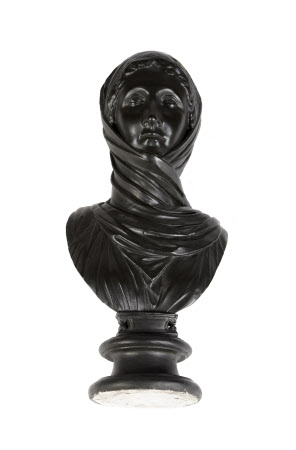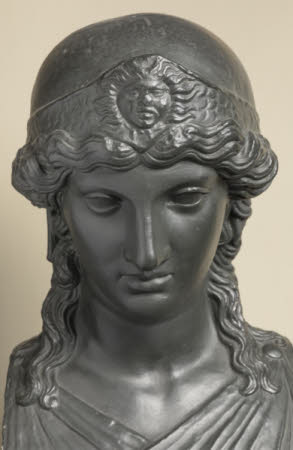Seven busts of Greek and Roman philosophers, writers, gods and goddesses
workshop of Matthew Brettingham the Younger (1725 - 1803)
Category
Art / Sculpture
Date
circa 1758
Materials
Bronzed plaster
Place of origin
London
Order this imageCollection
Kedleston Hall, Derbyshire
NT 108988
Summary
Bronzed plaster, seven busts of Greek and Roman philosophers, writers, gods and goddesses, probably cast in London, possibly by Bartolomeo Mattevali, on behalf of Matthew Brettingham (1725-1803), c.1758. A set of seven portrait busts cast in plaster after antique busts in Roman collections, painted to look like bronze, mounted on bronzed plaster socles atop the bookshelves in the Library of Kedleston Hall. The busts depict: Socrates (NT 108988.1), Homer (NT 108988.2), Athena (NT 108988.3), a Vestal Virgin (NT 108988.4), Pindar (NT 108988.5), Sappho (NT 108988.6), and finally Dionysus (NT 108988.7).
Full description
During his seven-year stint in Rome (1747-54) Matthew Brettingham not only dealt in casts and antiquities - furnishing the Earl of Leicester, for example, with casts and marble statues for Holkham Hall - but also commissioned actual moulds to be taken from famous Roman antiquities. The idea was that casts could then be made to order when he returned to London. He commissioned moulds for sixty busts, divided between Greek and Roman subjects, and twelve moulds of full-size statues. In addition to the 10 casts of statues he purchased for the Marble Hall, Nathaniel Curzon, 1st Baron Scarsdale (1826-1804), bought many of the classical busts on Brettingham’s books. Seven are mounted on top of the bookcases (NT 108611) in the Library of Kedleston Hall, in a display related to Robert Adam’s proposed designs for the room (see NT 109438–109442).The busts depict: the Greek philosopher Socrates; Homer, the legendary Greek author of the Iliad and Odyssey; the Greek goddess Athena; a Vestal Virgin of Rome; the Greek poets Pindar and Sappho; and Dionysus, Greek god of wine and revelry.Brettingham's Rome Account Book, his ledger of statues dealt, casts made, bought and sold when he was in Italy, confirms that the Library busts were moulded from some of the most prestigious antiquarian collections in Rome. ‘Socrates’ and ‘Sappho’ were cast after busts in the Villa Albani, a palace purpose-built to house Cardinal Alessandro Albani’s renowned collection of antiquities and classical sculpture (Kenworthy-Browne 1983, p. 93). ‘Homer’ and the ‘Vestal Virgin’ were after busts in the Farnese collection, assembled by one of the most powerful aristocratic and papal families in Europe (Kenworthy-Browne 1983, pp. 58, 73, 94, 97). ‘Athena’ and ‘Pindar’, meanwhile, come from the Capitoline Museums, the world’s first public museum owned by the municipality of Rome (Kenworthy-Browne 1983, pp. 73, 74, 94). The anomaly is the bust of ‘Dionysus’, which in the 18th century was understood to depict the Greek philosopher Plato. The reattribution is owed to Adolf Michaelis, whose survey of antiquities at Holkham Hall included the Roman herm from which the Kedleston Dionysus was cast. That herm was ‘dug up in a vineyard near the Church of St John Lateran’, bought by Brettingham in 1752, moulded and eventually sold to the Earl of Leicester for Holkham. The cast was sold to Curzon as ‘Plato’ in 1758 (Michaelis 1882, p. 317, no. 47; Kenworthy-Browne 1983, pp. 59, 66, 78, 80). A receipted bill, dated 23 January 1758, exists in the Kedleston Archive for five of the busts: ‘the Farnesian Homer’ for which Brettingham charged Lord Scarsdale £2-0s-0d (just over £200 in today’s money) and the ‘Vestal Virgin’, ‘Pindar’, ‘Socrates’ and ‘Plato’ (i.e. Dionysus) all charged at £1-10s-0d (just over £150). The other two (Athena and Sappho) certainly came from Brettingham, although no bill or receipt exists to prove a transaction. All seven busts are listed in Nathaniel Curzon’s handwritten ‘List of Statues I have’, under the heading ‘Plaister Busts’ (c. 1760; MS, Kedleston Archive). Confusingly some busts have been incorrectly named in both Curzon’s manuscript list and in the 1769 printed ‘Catalogue of the pictures, statues, &c. at Kedleston’ (p. 13). The concordance is clarified below, starting with the National Trust inventory number and correct, up-to-date title: NT 108988.1 Socrates: listed as Socrates in ‘List of Statues I have’ and as Socrates in the 1769 ‘Catalogue’ NT 108988.2 Homer: listed as Homer in ‘List of Statues I have’ and as Homer in the 1769 ‘Catalogue’NT 108988.3 Athena: listed as ‘Aspatia’ (i.e. Aspasia) in ‘List of Statues I have’ and as Virgil in the 1769 ‘Catalogue’NT 108988.4 Vestal Virgin: listed as Vestal in ‘List of Statues I have’ and not listed in the 1769 ‘Catalogue’ NT 108988.5 Pindar: listed as Pindar in ‘List of Statues I have’ and as Pindar in the 1769 ‘Catalogue’NT 108988.6 Sappho: listed as Sappho in ‘List of Statues I have’ and as Sappho in the 1769 ‘Catalogue’NT 108988.7 Dionysus: listed as listed as Plato in ‘List of Statues I have’ and as Anacreon in the 1769 ‘Catalogue’‘Socrates’, ‘Sappho’, ‘Pindar’ and ‘Homer’ concord. The bust catalogued as ‘Virgil’ in 1769 is called ‘Aspatia’ in Curzon’s list and ‘Aspasia’ by Brettingham because in 1750 Giovanni Bottari, the Pope’s Librarian, suggested that the bust might show Aspasia, the intellectual and mistress of Pericles whose writings influenced Socrates and Plato (Kenworthy-Browne 1993, p. 252). Aspasia is in fact ‘Athena’, wearing her signature helmet. ‘Plato’ was the name given to Brettingham’s excavated antiquity at St John Lateran, although in 1769 it was catalogued ‘Anacreon’ (the bearded Greek lyric poet) and both names were later rejected by Adolf Michaelis in favour of a ‘pseudo-archaic’ depiction of ‘Dionysus’ (Michaelis 1882, p. 317 no. 47).‘Horace’, peculiarly, is the seventh bust listed in the 1769 ‘Catalogue’, however it does not appear in Curzon’s manuscript list and to this cataloguer’s knowledge no antique prototype for Horace exists. The ‘Vestal Virgin’ is not listed in the 1769 ‘Catalogue’, but does appear in Curzon’s handwritten list.Alice Rylance-WatsonMarch 2019
Provenance
Purchased by Nathaniel Curzon, 1st Baron Scarsdale (17126-1804) in c. 1758; see receipted bill dated 23 January 1758 for five of the busts (Homer, Vestal Virgin, Pindar, Socrates and Plato (i.e. Dionysus), each bust at £1-10-0 (MS, Kedleston Archive); identifiable, although with some incorrect titles, in the 1769 'Catalogue of the pictures, statues, &c. at Kedleston' (p. 13) as 'Busts of Homer, Sappho, Socrates, Virgil (incorrect), Anacreon (incorrect), Pindar, Horace (incorrect); identifiable in the 1861 'Catalogue' (p. 13), the busts listed as exactly as they were in 1769; purchased with part of the contents of Kedleston Hall with the aid of the National Heritage Memorial Fund in 1986 when the house and park were given to the National Trust by Francis Curzon, 3rd Viscount Scarsdale (1924-2000).
Credit line
Kedleston Hall, The Scarsdale Collection (acquired with the help of the National Heritage Memorial Fund and transferred to The National Trust in 1987)
Makers and roles
workshop of Matthew Brettingham the Younger (1725 - 1803), dealer possibly Bartolomeo Mattevali, caster
References
Kenworthy-Browne 1983: John Kenworthy-Browne, 'Matthew Brettingham's Rome Account Book 1747-1754', The Volume of the Walpole Society, vol.49 (1983), pp.37-132 Michaelis 1882: Adolf Michaelis, Ancient Marbles in Great Britain described by Adolf Michaelis, Cambridge 1882, p. 317, no. 47 Kenworthy-Browne 1993: John Kenworthy-Browne, ‘Designing around the statues. Matthew Brettingham’s casts at Kedleston’, Apollo, April 1993, pp.248-252




























